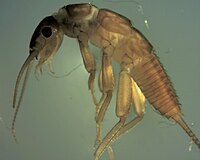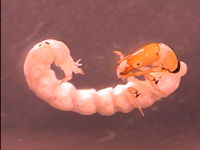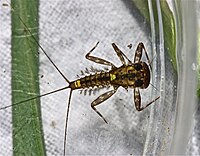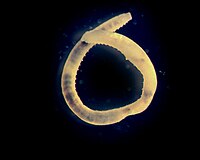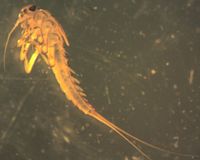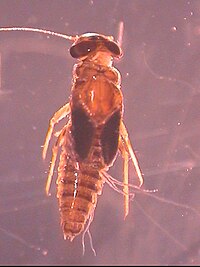French Hill Brook
From WikiEducator
| Stream code: | LR_FrbchHl_992 |
| Basin: | Lamoille River |
| State or Province: | Vermont |
| Country: | USA |
| Latitude: | 44.60927021 |
| Longitude: | -72.70304147 |
| School: | Johnson State College |
The following are the most common invertebrates collected from this stream site.
Contents
Capniidae
Capnia stoneflies have hind wing pads that are are broad as they are long. An important distinction of the Capniidae family is the membranous pleural folds that run down the posterior abdomen segments 1-9. These look like two lines running parallel down the back of the abdomen. Capnia are distinguished by femurs and tibia of forelegs with less than 20 fine hairs and no dorsal femoral fringe hairs.
Chironomidae
Midge larvae tend to be the most common macroinvertebrate at our sites. As with other Diptera, there are no true jointed legs. Chironomidae do have a pair of prolegs at each end and preserved individuals tend to curl into a 'C'. Identification past family requires slide-mounted heads. We have seen philopotamid caddisflies misidentified with the chironomids and we suspect that that happens when samples are being sorted from trays. Under a microscope, six prominent legs can be seen on members of the caddisfly family Philopotamidae.
More information on Philopotamidae.
Chimarra
Chimarra are distinguished from the other Philopotamidae by a prominent asymmetrical notch in the frontoclypeus as well as a prominent process on the femur which bears a single hair (seta).
Images of the asymmetrical notch and prominent process.
Heptagenia
Heptagenia are easily characterized by their flat head. The claws have just one basal tooth and no denticles (serrated edges). The gill on abdominal segment 7 has multiple fibrils at is base (thread-like structures) and has a single tooth on its claws but is smooth otherwise. Gills on segment 7 are similar to those on all other segments, but may be smaller in size.
Oligochaeta
Aquatic earthworms lack legs and are characterized by having 20 or more segments. Unlike leeches, they lack a suction disk. We collect members of two or more orders in this class as small numbers of stream sites and they are rarely numerous. They are more common at pond and lake sites.
Image of the 20 or more segments.
Baetidae
This mayfly has either two or three cerci ("tails") and a unique head shape. Its gills are oval shaped and insert dorsally. Commonly encountered genera include Acerpenna, Baetis and Pseudocloeon.
More information on the genera:
Baetis
- Order
- Ephemeroptera
- Family
- Baetidae
- Genus
- Baetis
- Common name
- The Little Olive
- Tied fly
- Sawyer Pheasant Tail Nymph
This mayfly has three "tails" and a unique head shape. Its gills are oval shaped and insert dorsally. More mature nymphs have long, dark wing pads.
Image of the long, dark wing pads.
Philopotamidae
Philopotomidae are net-spinning filtering collectors. A casual observer might sort them with Chironomidae, but a close look reveals six jointed legs. The faint white 'T' shaped labrum extending from the front of the head past the mandibles is diagnostic for the family (it is sometimes withdrawn and hard to see).
Image of the faint white 'T' shaped labrum. Common genera include Dolophilodes, Wormaldia, and Chimarra.
Leptophlebiidae
Leptophlebiidae are characterized by a somewhat flattened body and forked elongate gills. Commonly found genera include Habrophlebia and Paraleptophlebia.
Image of the forked elongate gills.

